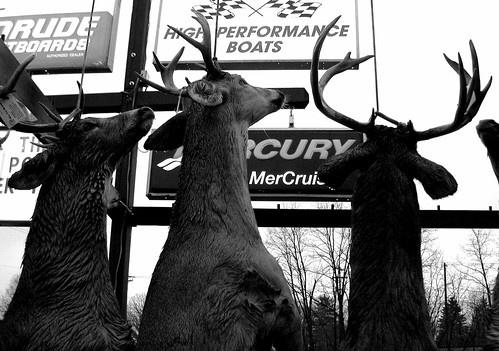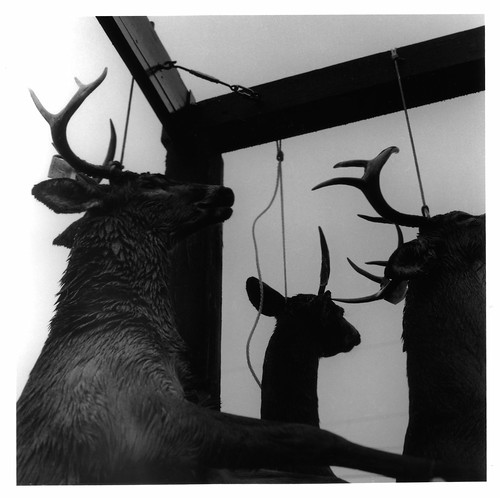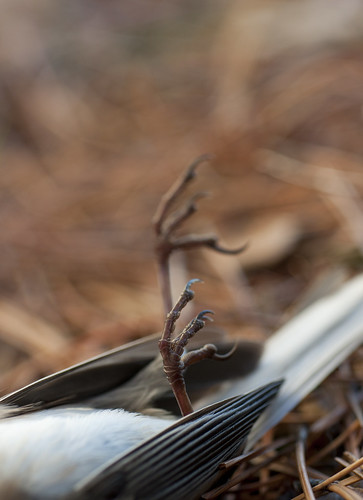Seeing full-grown deer strung up by their antlers is a rather sobering experience. They suddenly become massive; their bellies are open and steaming, their tongues loll out and their eyes are open. Depending on your background and upbringing, it can be a horrific sight, or a fascinating one, or a joyful one, or any combination thereof. Whatever the case is, it's certainly a good opportunity for photography.
Tuesday, November 15, 2011
Opening Day
Six years ago, I took some of my first photographs of dead animals. I didn't have any plan in mind for them, nor had I thought up any type of social statement, but they are certainly interesting to look back at. Today is opening day of rifle season for deer here in Michigan, so in recognition of that, here are a few photographs from November 2005 of the buck pole in Dexter.
Monday, November 14, 2011
Another Day, Another Raccoon
Raccoons are probably the most common road casualty along Marquette's stretch of US 41. For a while, I was tallying them as they were hit, but I've long since lost count. There's a particular area where the bodies of raccoons really seem to pile up, and it's a small span of the highway, between the newly-built traffic circle and the Altamont Street bridge:
Why is this spot such a death trap for raccoons? For one, the four-lane highway cuts between a neighborhood and a wooded area, both of which are ideal locations for raccoons to live. In addition, there's a divider that runs the whole length of this stretch, separating opposing traffic. If a raccoon were to somehow make it halfway across the road, getting around this barrier would be a challenge, especially with cars whipping by at sixty miles an hour.
As a result, raccoons die in great numbers along this small stretch of highway. A few weeks ago, I got a call from Steph; she was talking to one of her classmates, and he'd spotted a freshly-hit raccoon in this area. I had been on the lookout for a sizable raccoon for taxidermy purposes, so after work, I retrieved it, then froze it for skinning at a later, more convenient time.
Before making any incisions, I briefly photographed the raccoon.
click for larger view
Why is this spot such a death trap for raccoons? For one, the four-lane highway cuts between a neighborhood and a wooded area, both of which are ideal locations for raccoons to live. In addition, there's a divider that runs the whole length of this stretch, separating opposing traffic. If a raccoon were to somehow make it halfway across the road, getting around this barrier would be a challenge, especially with cars whipping by at sixty miles an hour.
As a result, raccoons die in great numbers along this small stretch of highway. A few weeks ago, I got a call from Steph; she was talking to one of her classmates, and he'd spotted a freshly-hit raccoon in this area. I had been on the lookout for a sizable raccoon for taxidermy purposes, so after work, I retrieved it, then froze it for skinning at a later, more convenient time.
Before making any incisions, I briefly photographed the raccoon.
This individual, who weighed in at around ten pounds, was a juvenile male. His winter fur had grown in thick and full; he had a few burrs stuck in his curiously stubby tail. The skinning process revealed the layer of fat that he'd put on for the approaching winter, and it was a rather impressive sight to behold.
While they are hit incredibly often by cars, raccoons can also owe their success to people. These animals have come to coexist with humans, enjoying open garbage cans, dumps, and the refuse that people leave behind. Neighborhoods are generally free of predators, allowing raccoons to reproduce and thrive, with little fear of being eaten. With this explosion in raccoon numbers, there of course comes a negative impact to the environment. One of the problems I've heard is that the numbers of frogs, salamanders, and turtles have fallen, due in part to the sheer amount of raccoons consuming them. This is especially an issue in smaller ponds and streams located in or around residential areas.
Traffic, then, has become the chief enemy and population-controller for raccoons. It's an interesting relationship to consider; as humans we both build up the populations of these animals, as well as tear them down. Just the other day, yet another raccoon had been hit along that stretch of US 41, in bloody, violent fashion. When Steph drove by, a crow was helping itself to the carcass.
Thursday, November 3, 2011
A Year Later
Just over a year ago, I photographed a dark-eyed junco that had collided with a window in Ann Arbor. Almost 500 miles away, and 368 days later, another junco hit a window, here in Marquette, and again, I was alerted to its presence. Found by a friend, it rested at the foot of the NMU Art Building, another casualty of the structure's large windows.
Unlike the dark juncos that frequent our yard, this junco was a light brown-gray. Its eyes were open, its neck limp, its feathers barely ruffled out of place. I brought the junco home to photograph, resting its body on a bed of fallen pine needles.
Unlike the dark juncos that frequent our yard, this junco was a light brown-gray. Its eyes were open, its neck limp, its feathers barely ruffled out of place. I brought the junco home to photograph, resting its body on a bed of fallen pine needles.
Juncos are a sure sign of winter; they arrive as the air turns cooler and the days become shorter. They are regular visitors of our backyard bird feeder, and seem to coexist peacefully with the mourning doves while foraging on the ground for millet. As I photographed this junco, several were nearby, keeping a wary eye on me as they searched for food.
I do realize the last few posts here have been undeniably bird-centric – that will change, to the tune of raccoon, and I've got a few announcements to make, as well. Stop by again soon! Updates will be more frequent in the coming weeks.
Labels:
Junco,
Marquette,
Michigan,
Upper Peninsula,
window collision
Subscribe to:
Posts (Atom)










